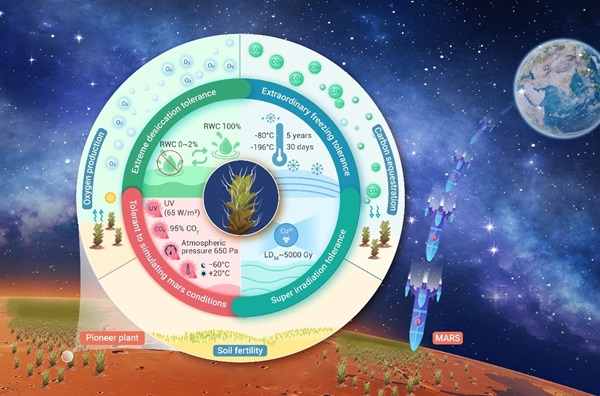Researchers Discover Promising Pioneer Plant for Colonizing Extraterrestrial Environments
2024-07-04
In a research paper published in The Innovation, the research team led by Prof. ZHANG Daoyuan and Prof. ZHANG Yuanming from the Xinjiang Institute of Ecology and Geography (XIEG) of the Chinese Academy of Sciences, along with Academician KUANG Tingyun from the Institute of Botany of the Chinese Academy of Sciences, evaluated the extraordinary resilience of an extreme stress-resistant desert moss—Syntrichia caninervis.
Syntrichia caninervis demonstrates an exceptional suite of regulatory and adaptive mechanisms across morphological, physiological, and molecular levels, allowing it to thrive in extreme environments such as deserts and polar regions.
For morphological adaptations, Syntrichia caninervis has overlapping leaves that conserve water and protect the plant from intense sunlight. The white awns reflect strong solar radiation and enhance water utilization efficiency. Twisted leaves minimize surface area and reduce transpiration.
For cellular and physiological adaptations, Syntrichia caninervis maintains cellular integrity in dehydrated state. The moss enters a state of selective metabolic dormancy under stress, preserving key metabolites like sucrose and maltose as protectants. It has a strong ability to scavenge reactive oxygen species.
For molecular regulatory mechanisms, Syntrichia caninervis has expanded stress-related late embryogenesis abundant (LEA) and catalase genes, as well as tandem duplication of genes encoding photoprotective early light-induced proteins (ELIPs). There is selective upregulation of genes and proteins involved in critical stress response pathways in Syntrichia caninervis.
The researchers tested the extraordinary resilience of Syntrichia caninervis under extreme desiccation, ultra-low temperatures, and intense radiation, as well as in a simulated Martian environment combining several of these stress factors.
The results showed that Syntrichia caninervis can withstand losing of more than 98% of its cellular water, deep freezing at ultra-low temperatures of -196°C for months, and super gamma radiation exceed 5000 Gy. Moreover, it can still survive and maintain vitality under simulated Martian conditions (650±30 Pa, -60°C to 20°C, 95% CO2, ultraviolet radiation). The results indicate that Syntrichia caninervis is one of the toughest plants on Earth.
"These findings have set new records of the tolerance of organisms to extreme environments, and offer new possibilities for future Mars colonization and the reconstruction of ecosystems,” said Prof. LI Xiaoshuang, first author of the study.
This study provides insights into the survival limits and adaptation strategies of Syntrichia caninervis, and lays a foundation for human exploration of outer space and the creation of habitable planets.
Article link: https://doi.org/10.1016/j.xinn.2024.100657

Syntrichia caninervis can survive under extreme environments. (Image by XIEG)
Contact
LONG Huaping
Xinjiang Institute of Ecology and Geography
E-mail: longhp@ms.xjb.ac.cn
Web: http://english.egi.cas.cn



